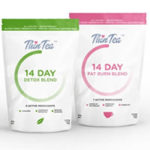The 5 Healthiest Types of Tea You Should Be Drinking
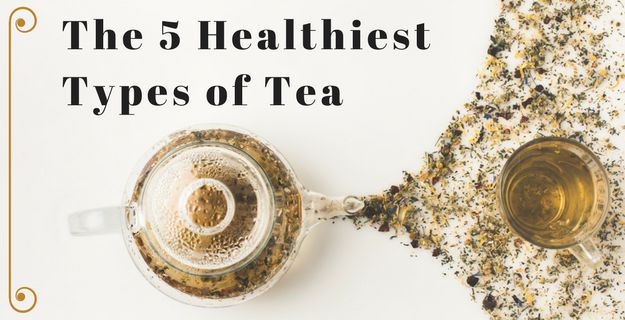
Variety is the spice of life and it’s beautifully seen in the various types of tea available to us around the world.
There are literally thousands of different varieties of tea.
That means your perfect cup of tea is out there!
No matter your mood, taste, or health goals, there’s a tea to fit all of your wants and needs.
We’re very fortunate to have such a wide array of teas at our fingertips.
But if you’re anything like me, decision-making isn’t one of your strong suits.
With so many teas choices, how in the world do you pick one… especially the best one?
Well, that’s why we’re here!
We’re going to go through the most beneficial teas and by the end of the article, you’ll have your perfect tea picked out.
So, what are you waiting for?
Let’s get this [tea] party started!
5 Types Of Tea And Their Health Benefits
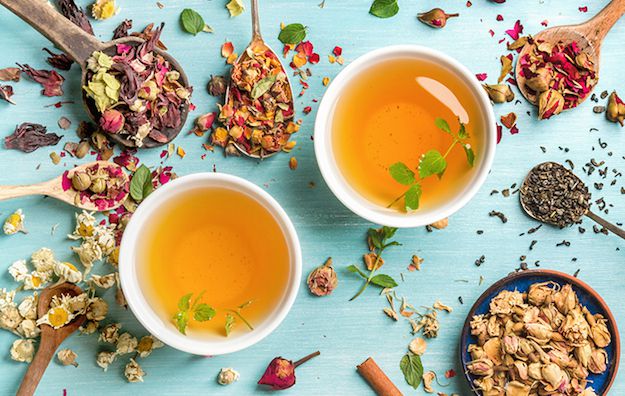
Image via Clean Plates
Like we said earlier, there are countless types of tea out there.
However, all true teas are made from the same plant, Camellia sinensis.
True teas consist of green tea, black tea, white tea, and oolong tea.
All other teas are just herbal elixirs with botanical compounds.
So how do we get such uniquely different types of tea from the exactly same plant?
It all comes down to the way the plants are grown, harvested, and prepared.
A key player is oxidation.
You might be familiar with it because it gets thrown around a lot in terms of tea.
Oxidation is a reaction that occurs when leaves are cut or bruised and the injured plant tissue is exposed to oxygen in the air.
Plant tissue naturally contains protective antioxidant molecules (the beneficial stuff we get from drinking tea) that help prevent oxidation from happening.
The leaves absorb oxygen, which changes the chemical and enzymatic structure and then begins to break down and brown the leaves.
Think of when you slice or bruise an apple, it starts to turn brown after a little while. That’s oxidation!
This reaction radically changes the appearance, flavor, aroma, and chemical composition of the tea leaves.
All types of tea go through different oxidation processes while being made.
For instance, oxidation is deliberately initiated, controlled, and then stopped in some teas.
Others are prevented from being oxidized altogether.
It’s important to know that they all have antioxidant, anti-inflammatory, antibacterial, and antiviral properties.
This is true because of their shared contents of catechins, a type of disease-fighting flavonoid and potent antioxidant.
That being said, each tea has its own specific health benefits.
This is where we start pairing down each one to find your new go-to brew.
1. White Tea
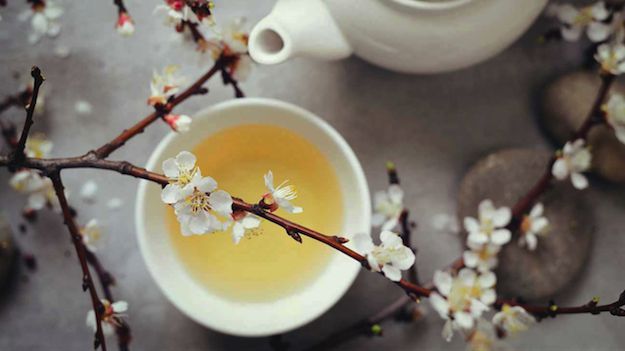
Image via Healthline
White tea is the least processed of the bunch and has minimal oxidation.
It’s made from brand-new buds and very young tea leaves from the Camellia sinensis plant.
To stop the oxidation process, the buds and leaves are steamed and delicately dried.
This minimal processing gives white tea a bit more antioxidant power compared to other types.
It’s known for its mild flavor, light color, and slight sweetness.
The flavor profile ranges but common notes are floral, fruity, grassy, peach, apricot, vanilla, and honey.
It’s incredibly easy to drink and a great choice if a bold flavor isn’t your cup of tea.
White tea has the lowest caffeine content, coming in at about 15 – 20 milligrams (mg) of caffeine per cup.
So it works as a nice little pick-me-up if you aren’t a fan of highly caffeinated beverages.
It touts multiple health benefits.
Some of these include cancer-fighting benefits, reduced risk of cardiovascular conditions, increasing weight loss, and improvement of oral health.
It may also help with diabetes due to its ability to reduce LDL cholesterol and improve glucose tolerance.
White tea has been shown to help reduce inflammation (especially with chronic inflammation), protect against osteoporosis, and boost immune function.
2. Green Tea

Image via Medical Daily
Green Tea is one of the most popular teas today, especially in terms of its health benefits.
Check out the Top 6 Health Secrets of Green Tea to learn even more about this healthy green botanical brew.
Green tea undergoes minimal oxidation like white tea, and it’s much less processed than black or oolong tea.
The leaves are harvested and then quickly preserved.
Heat is used to deliberately stop the oxidation process from happening. This keeps the leaves very pure and gives it that fresh-picked flavor and green color.
Similar to white tea, the reduction of oxidation allows for incredibly high amounts of catechins, particularly the ridiculously healthy compound called epigallocatechin gallate (EGCG).
Green tea has a bolder, grassier flavor to it.
It’s commonly described as sweet, bittersweet, floral, vegetal, buttery, fruity, swampy, and oceanic.
It has a higher caffeine content compared to white tea.
Green tea has around 25 – 35 mg of caffeine per cup.
The health benefits of green tea are incredibly vast and rather remarkable.
These include increased metabolism, weight loss via burning of fat, lowered risk of stroke, reduced risk of neurological disorders such as Parkinson’s and Alzheimer’s disease, lowered risk of certain cancers (breast, bladder, pancreatic, colorectal, stomach, and lung), improved skin tone, and lessened inflammation.
BONUS: There’s a special kind of green tea leaf that’s used to make a powdered tea called matcha.
Click to read this article about matcha tea to find out what it is!
3. Black Tea
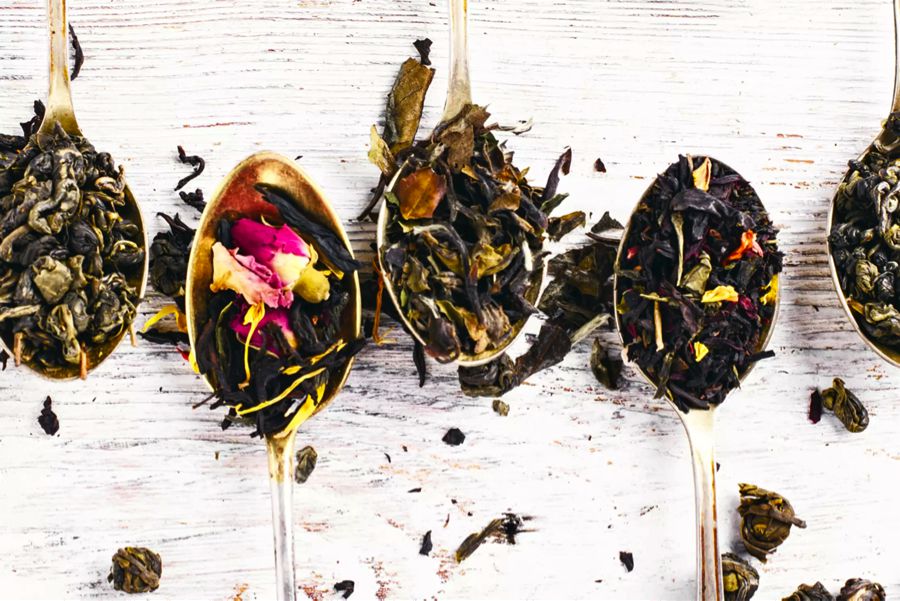
Image via Mind Body Green
Black tea is a classic among the various types of tea.
It’s also the most commonly consumed.
This particular tea is allowed to wither before oxidation occurs.
The leaves are sometimes deliberately bruised, breaking down the cell walls and facilitating enzymes to start the natural oxidation process.
It’s typically fully oxidized.
This gives the final dark brown and black appearance to the tea leaf.
Black tea has a stronger, more robust flavor compared to other types of tea.
Some common flavor characteristics of it are smoky, earthy, nutty, spiced, malty, caramel, and citrus.
It has a higher caffeine content, as well.
Black tea has about 50 mg of caffeine per 8-ounce cup.
So if you’re a habitual coffee drinker, black tea might be a great option for you.
Some of the most common types of black tea are English Breakfast, Earl Grey, and Irish Breakfast.
Now let’s talk about the health benefits.
Black tea can help the body in many ways.
One way is that it helps protect your heart.
Studies show that drinking 3 cups of black tea per day may lower blood pressure.
It also suggests those drinking 3 – 4 cups per day reduce their risk of stroke by 21%.
These benefits are due to the flavonoids and caffeine in this robust tea.
Other research points to the theaflavins and thearubigins (antioxidant compounds) in black tea, which may also help lower cholesterol levels.
Additional benefits include improved blood circulation and digestive problems, especially in treating diarrhea.
So, aim for 3-4 cups per day to get the biggest benefit from this type of tea!
4. Oolong Tea
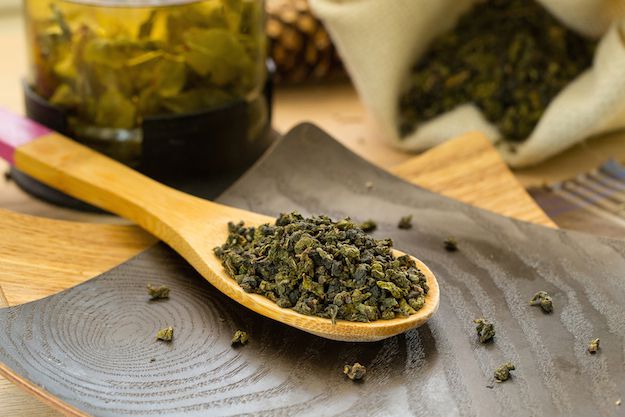
Oolong isn’t as widely popular as the other types of tea like black and green.
But that doesn’t mean it isn’t super healthy!
This tea is abundant in amino acids, vitamins, minerals, plus beneficial polyphenol antioxidants.
Oolong is a full-bodied tea.
That means the leaves can’t be picked prematurely, but only right as they peak.
Once the leaves are freshly picked, they’re intentionally bruised by being shaken or tossed.
They’re withered and then lightly rolled.
The tea leaves are allowed to partially oxidize and right after get roasted or heated to stop any further oxidation.
Sometimes the roasting and rolling process gets repeated multiple times.
The final product is rolled, twisted, and dried.
Oolong tea has a very characteristic shape to it.
The leaves are formed into tight balls or twisted into wiry shapes and strands.
It’s a full-bodied flavor profile that can range from toasty to sweet to grassy to floral.
It’s not as strong as black tea but not as light as green tea.
It has notes of fresh fruit and fresh flowers.
The caffeine content ranges from 35 – 55 mg per cup.
The health benefits from this tea are vast.
One big benefit is weight loss or maintenance.
Studies show that consuming oolong tea on a regular basis may lower your risk of obesity by increasing the metabolism of fat.
The polyphenols help activate thermogenesis and turn your body into a fat burning machine.
It may also help strengthen bones by increasing bone density, stabilize blood sugar levels, reduce stress, improve gut health, prevent tooth decay, and potentially prevent certain cancers.
5. Pu-erh Tea
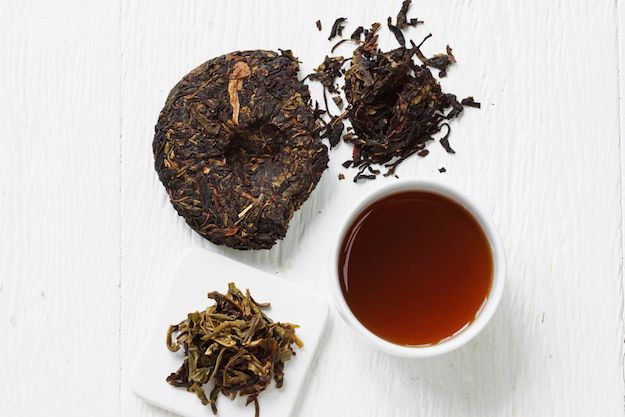
Image via The Spruce
Pu-erh Tea, also known as “puer” or “pu’er”, is pronounced POO-air.
Oh, how horribly wrong I’ve been pronouncing this silly sounding tea.
Aside from its silly name, but it’s actually considered rare among the various types of tea.
Anytime I hear rare, my interest definitely peaks!
This tea is definitely unique.
Why?
Well, Pu-erh Tea is aged and fermented.
Yes, fermented like yogurt, kefir, kombucha, or sauerkraut.
It has friendly bacteria like the kind you hear about in probiotic supplements!
Also, as we mentioned earlier, all true teas come from the same plant, Camellia sinensis.
However, pu-erh tea is from a large-leaf variety of Camellia sinensis called “Yunnan Dayeh”, or if you want to get technical, Camellia sinensis var. assamica.
Another interesting thing is that there are two totally different ways to process this special tea.
One is called Sheng Pu-erh, Green Pu-erh, or raw.
This is the traditional method that’s incredibly time consuming.
The leaves are very lightly processed and oxidized (like with white tea).
Oolong tea leaves are picked, heated or roasted to prevent oxidation, and sun dried.
The leaves are compressed into cakes and aged.
The aging process is carefully monitored under strict conditions in order to properly ferment the tea leaves.
Traditional sheng teas are aged for 3-5 years and up to 15-20+ years to achieve a delightfully rich, deep, complex flavor.
The second way is called Shou Pu-erh, Black Pu-erh, or ripened.
This method results in fully oxidized tea leaves and drastically reduces the processing time.
A technique called wet piling or wet storage is used to expedite the fermentation.
It’s like composting and involves piling up semi-fermented leaves, wetting them, and turning them to finish the process.
The piles of leaves are dampened and covered with cloth to create a humid, warm climate that facilitates the growth of friendly bacteria.
Shou pu-erh only takes 45 days to complete, fermentation and all!
The result is a full flavored tea with notes of earthy, mushroom-esque flavors that don’t have a bitter aftertaste.
It’s particularly appealing to coffee lovers since it’s deep, robust, and exceptionally rich like your favorite Cup of Joe.
This tea also pairs nicely with rich, decadent desserts or pastries.
Shou or Black Fermented Pu-erh tea has 60 – 70 mg of caffeine per 8 oz cup.
Sheng or Green Pu-erh tea has less caffeine, about 30-45 mg of caffeine per cup.
And, of course, drinking pu-erh tea has its unique set of health benefits.
Some of the main benefits are weight loss, lowering of cholesterol levels, and increased heart health.
Studies suggest that drinking pu-erh tea may help lower triglycerides and LDL (‘bad’) cholesterol, while raising HDL or the ‘good’ cholesterol.
It may also help lower your risk of stroke and lower blood pressure.
The weight loss aspect comes from the idea that this tea boosts metabolism and thus can help you torch fat and calories.
This tea has long been used for digestion and “blood cleansing”.
It’s usually consumed following a big meal or after a heavy night of drinking.
It’s essentially an ancient hangover cure!
Pinkies Up, It’s Tea Time!

Now that you’re acquainted with the 5 main types of tea, it’s time to get your sip on!
Tea is a glorious botanical beverage that somehow tastes yummy and oh so soothing while simultaneously giving you a great deal of health benefits.
As you read, these types of tea don’t just have one measly little health benefit.
Each has a remarkable number of benefits for the body, inside and out.
That means no matter which tea you choose, white, green, black, oolong, or pu-erh, you’re going to win.
You just can’t lose with tea. It’s the ultimate win/win – it tastes great AND nurtures your body.
So, tally up your favorites from today and decide which one works best for you.
Look at caffeine content, flavor profile, and health benefits.
Once you’ve narrowed it down, it’s par-tea time!
Or sereni-tea time. 😉
Whether you’re drinking tea to wind down or lift you up, it’ll always be there for you.
Just like there’s no “I” in team… but there is… TEA!
So team up with your favorite tea and make it a lovely daily habit.
We’ll toast our teas to that!
Category: Types of Tea








